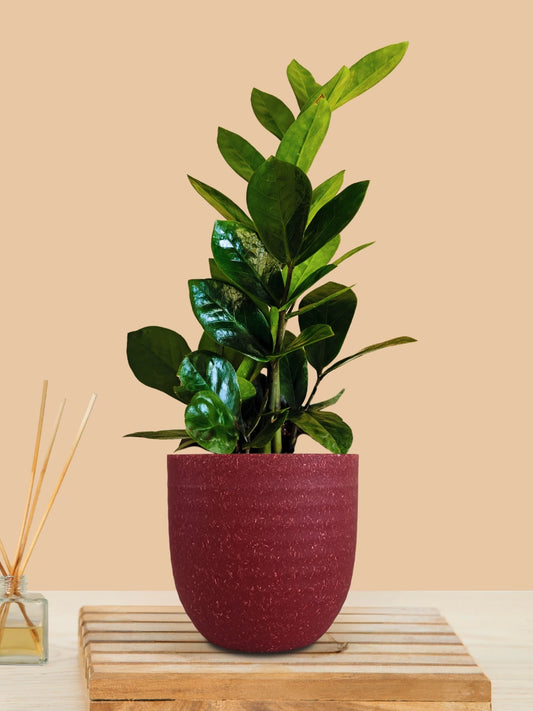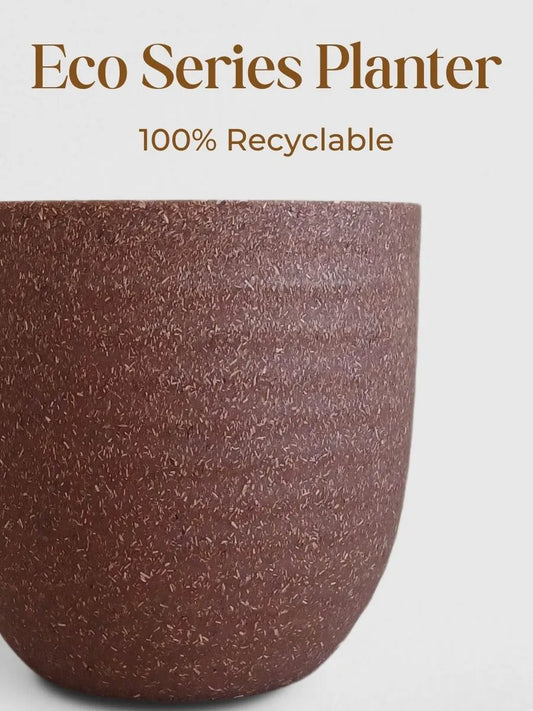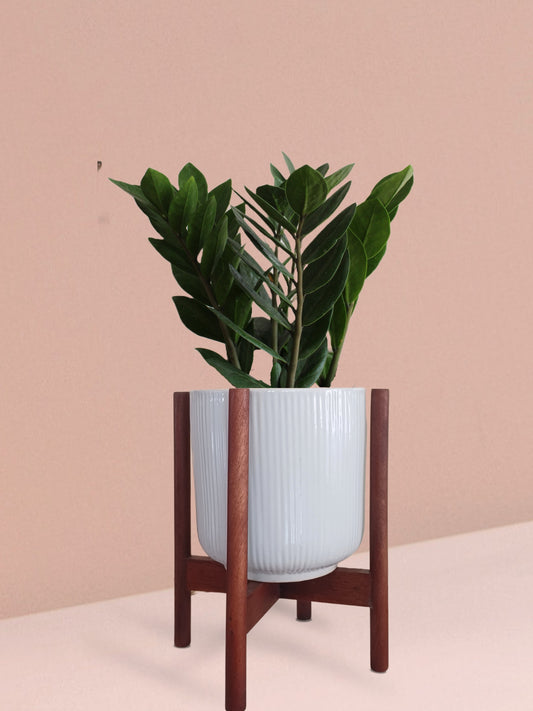
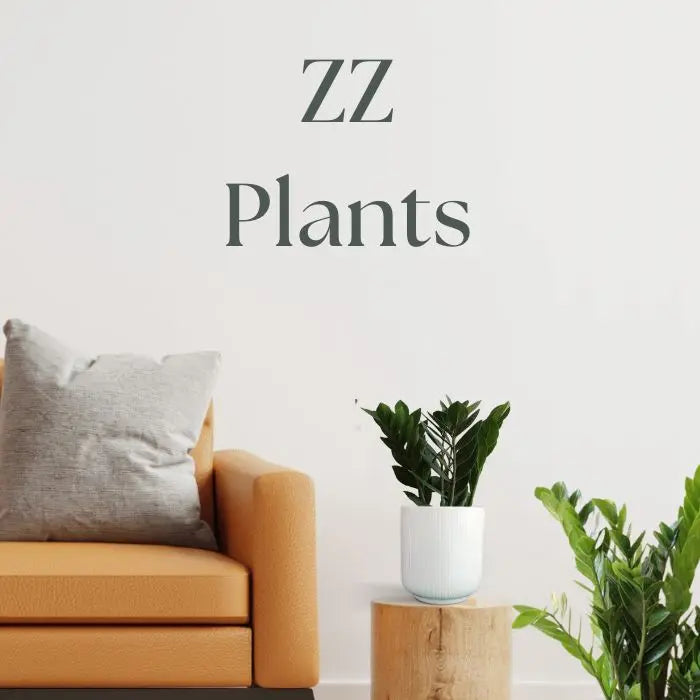
-
ZZ Green Plant (Small) in Eco Pot
Regular price ₹ 349Regular priceUnit price per₹ 749Sale price ₹ 349Sale -
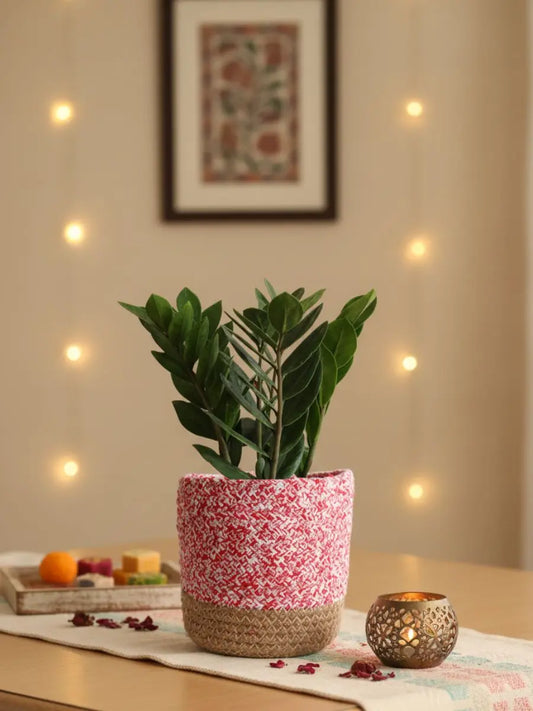
 20% Off
20% OffZZ Green (Medium)
Regular price From ₹ 639Regular priceUnit price per₹ 799Sale price From ₹ 639Sale -
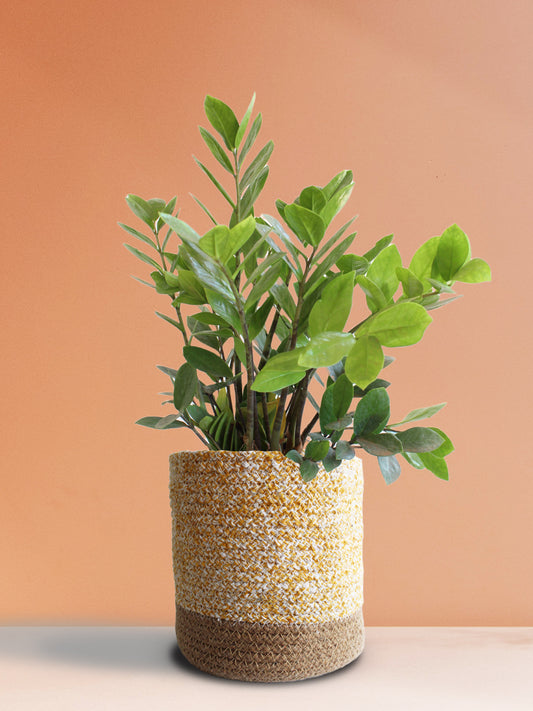
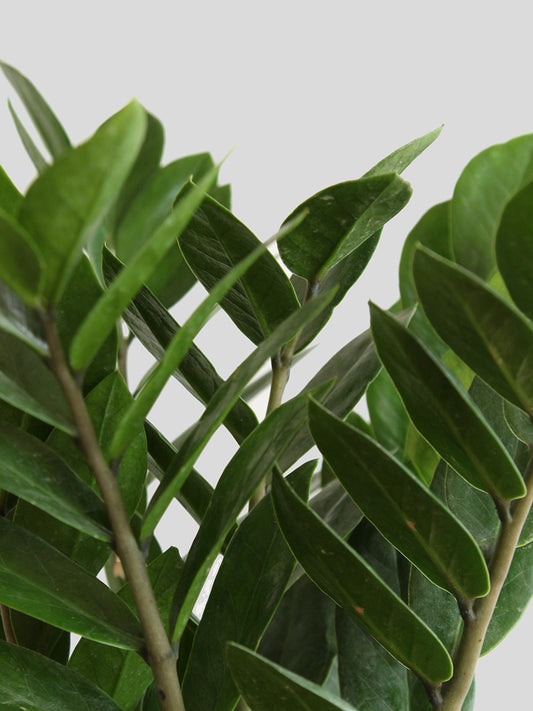 20% Off
20% OffZZ Green (Large)
Regular price From ₹ 959Regular priceUnit price per₹ 1,199Sale price From ₹ 959Sale -
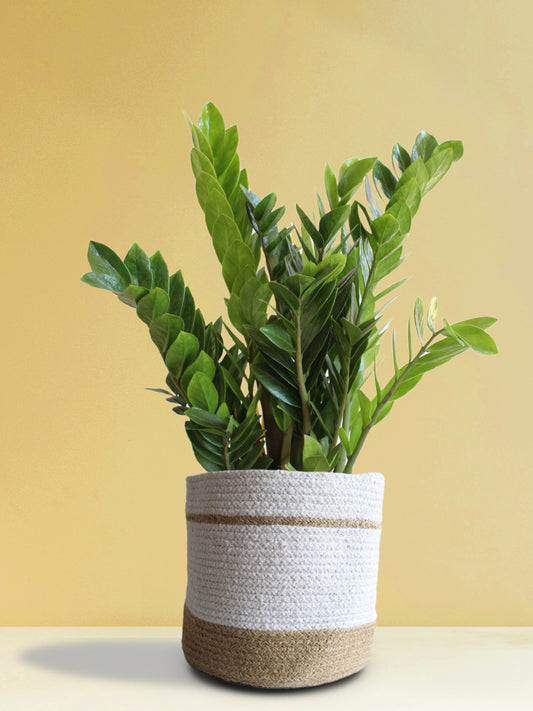
 Sold out
Sold outZZ Green (X-Large)
Regular price From ₹ 2,239Regular priceUnit price per₹ 2,799Sale price From ₹ 2,239Sold out -
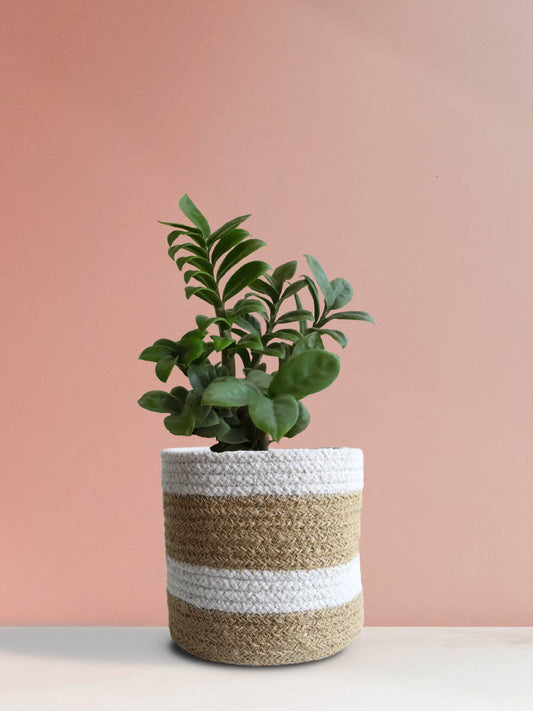
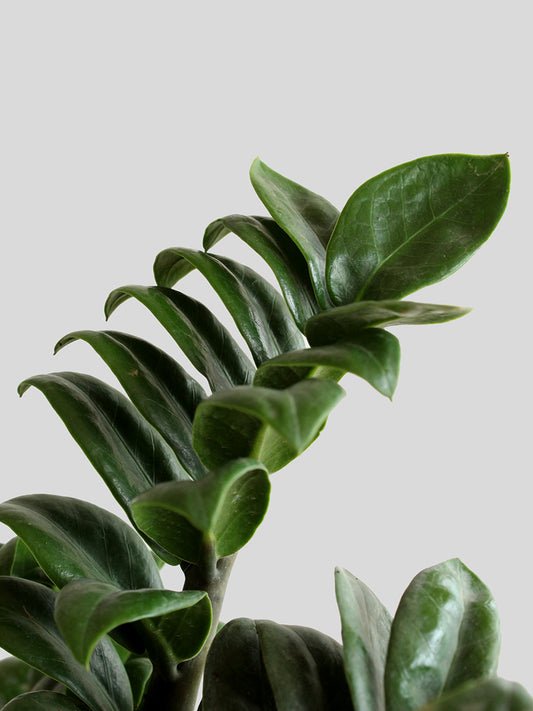 50% Off
50% OffZZ Zenzi (Medium)
Regular price From ₹ 499Regular priceUnit price per₹ 999Sale price From ₹ 499Sale -
ZZ Green Plant in Ceramic Pot (Medium)
Regular price ₹ 1,919Regular priceUnit price per₹ 2,399Sale price ₹ 1,919Sale
Let customers speak for us
Buy ZZ Plants Online
Continue scrolling to discover facts about ZZ plants, why we buy them, what to consider before buying them, their benefits at home, how to position them, and how to care for them.
History and Origin of the ZZ Plant:
In 1829, Loddiges initially identified the ZZ plant as Caladium zamiifolium. Heinrich Wilhelm Schlott later reclassified it to the genus Zamioculcas, and Adolf Engler renamed it. Zamioculcas zamiifolia is a genus whose name is derived from the resemblance of its foliage to that of the cycad genus Zamia and its relationship to the Araceae genus Colocasia. The species name, zamiifolia, means "leaves like zamia."
The ZZ plant, zamioculcas zamiifolia, is a tropical herbaceous perennial plant native to eastern Africa, including Kenya, Kwazulu-Natal, Malawi, Mozambique, Tanzania, and Zimbabwe. Its glossy foliage and ease of maintenance make it a popular houseplant. Common names include Zanzibar gem, Zuzu plant, aroid palm, eternity plant, and emerald palm.
Morphology of the ZZ Plant:
The ZZ plant has succulent, shiny, dark green leaves that grow in a feather-like pattern along thick stems. Its foliage is made up of leaflets that are smooth, glossy, and waxy in texture, giving it a unique appearance. Also, its roots are rhizomes, which are fleshy underground stems that store water and nutrients. And when the plant matures and gets the right conditions, it can produce small, yellowish-green flowers similar in appearance to those of other plants in the Araceae family ( in midsummer to early autumn).
Some Interesting Facts about ZZ Plants:
- The ZZ Plant is unrelated to Zamia, a unique genus, despite its name. In the Araceae, or "prayer plant" family, this plant is known as Zamioculcas zamioides (Spurges). Its leaves are somewhat reclined and grow erect.
- The ZZ plant has another name called "Eternity Plant." That's because, according to popular belief, it may live eternally. Its scientific name originates from its resemblance to cycads, prehistoric plants.
- The ZZ plant, which is also referred to as the “Aloe Tree” or “Fat Boy Plant," is recognised by its thick, fleshy leaves, which resemble aloe vera, as well as its swollen underground stem (rhizome), which reserves water and nutrients for the plant's survival during droughts.
- One interesting thing about the ZZ plant is that it can be replicated from just one leaf. The most common method is dividing the plant's rhizomes as it grows. The bulbous root system of the rhizomes helps the plant survive dryness by storing water. When it matures, the plant has a shiny leaf structure.
- As an Araceae plant, Zamioculcas zamiifolia is toxic, just like Philodendrons, Monstera, Anthuriums , Dieffenbachia, Aglaonemas, and Spathiphyllum, which contain insoluble calcium oxalate.
Why Choose Greenkin to Buy ZZ Plants
Among plant enthusiasts, Greenkin is the most renowned online plant shop for buying ZZ plants. Customers can be assured that their plant orders from Greenkin will be delivered with excellent quality plants. We offer many varieties of ZZ plants like ZZ Green ( Medium, Large , X-Large ), and (ZZ Zenzi Medium) in eco-friendly pots. We also offer plant combos which are pre-made combinations that pair ZZ plants with other plants to create the ideal aura in your living space.
Thus, whether you're a gardening beginner or an experienced enthusiast, ZZ Plant is perfect for anybody seeking a unique and beautiful plant to buy that will survive even when neglected. So, what are you waiting for? Order a ZZ plant today!
Things to Consider Before Buying ZZ Plants
Consider these factors before buying a ZZ plant:
- First, decide on a style for your home and yard. This plant's thick waxy leaves grow symmetrically from the base of its wand-shaped stalks to its tip, bringing nature indoors.
- Second, houseplant maintenance requires time management. Well, the ZZ plant survives in environments where most plants would die. Plus, it doesn't mind being watered infrequently, doesn't mind low light levels, or even has its roots cut. However, only occasional maintenance is needed to keep the ZZ Green Plant happy and healthy. Just need to give it enough water, light, and fertiliser.
- Thirdly, it is important to be aware that ZZ plants are toxic to pets. It is best to keep pets away from ZZ plants, it’s not a pet friendly plant .
Benefits of Having ZZ Plants at Home
- Health Benefits of Having ZZ Plants at Home: Being resilient and attractive, the ZZ plant offers many health benefits. According to a study , plants, including the ZZ plant, are believed to assist in the air purification process by absorbing volatile organic compounds (VOCs) such as benzene (a by-product of gas stoves) through their root systems. Plus, it also offers night-time oxygen, making the sleeping area fresh.
Furthermore, ZZ plant also has therapeutic benefits in traditional medicine, including therapies such as the Sukuma people in northwestern Tanzania use the roots to treat ulceration, while Malawi and Tanzania use leaf juice to treat earache and a poultice to treat inflammation called "mshipa". - Vast Benefits of Having ZZ Plants at Home: ZZ plants, like Chinese money plants, are considered by Feng Shui to bring good fortune to their growers. These plants are known as the "eternity plant" because of their durability and positive energy, which promotes prosperity and well-being. Vastu Shastra recommends placing your ZZ plant at the southeast corner of your room for wealth, success, and money. To boost your business's luck, place it near local stores' cash registers.
Placement Guide for ZZ Plants
The ZZ plant thrives under any conditions. They're great indoor plants for any room with little to no sunlight because they grow in low light and can survive at a range of temperatures. The best part? They're simple to maintain!
ZZ plant favourites include spots on your office desk or shelf, open spaces in your home that need greenery, spaces under plants or trees (they can handle shade!), vertical gardening patterns (terrariums!), miniature gardens ( hypertufa pots take it to the next level!), companion arrangements with other plants, etc.
How to Care for ZZ Plants
For the best possible development of ZZ plants, please follow these guidelines:
- Lighting Requirements of ZZ Plant: ZZ plants are very light-adaptable and are also known for their near-total shade tolerance. However, lack of light causes plants to become lanky and thin. Thus, provide at least two hours of indirect light per day or use a grow lamp to help your ZZ plant thrive.
- Watering Requirement of ZZ Plant: ZZ plants are exceptionally drought-tolerant since their rhizomes gather water. Although they can go months without water, they prefer a steady water supply. Also, the best growth happens when the soil dries fully between waterings. Plus, never leave ZZ plants in water—root rot and death will occur soon. Nevertheless, avoid overwatering (it hates it) and water sparingly in winter when growth slows or stops.
- Temperature and Humidity Requirement of ZZ Plant: ZZ plants may shed leaves to cope with environmental stress if neglected. Leaf drop is often caused by humidity instability or excessive temperatures. Keeping your home at a humidor-like level (a consistent relative humidity). Also, within an appropriate temperature range (below 40°C and above 5°C) protects your ZZ plants' health.
- How often should Fertilizer be used for ZZ Plants: ZZ plants don't require fertiliser every day. But to keep them healthy growth, you should feed them an indoor formula diluted to half strength once or twice during their active growing season.
- Is Pruning needed for ZZ Plants: It is advisable to prune ZZ plants’ leaves sparingly in order to prevent them from appearing leggy and thin. Use a sharp, sterile pruner to make 45-degree cuts just above a leaf node to make your plants look wider.
- Repotting a ZZ Plant: Repot your ZZ plant in spring or summer while it's growing to avoid transplant shock. Choose a larger pot or divide it and remove the outside rhizomes.
- Common Troubleshooting Management of ZZ Plant: Overwatering can result in various problems for ZZ plants, including yellowing the foliage. While older leaves rot and fall off, if your plant's younger leaves have lost their brilliant green colour, water less often. Repot the plant into a new, dry potting mix if necessary after it has completely dried out.
- Dusting a ZZ Plant: The ZZ plant's sparkling leaves are attractive. However, they collect dust and appear dull after a while. Thus, clean dust on its leaves with a moist cloth.
- Pest Control for ZZ Plant: Though rarely pest-infested, ZZ plants can be attacked by mealy bugs, scale, fungus gnats, and aphids. Keep plants dust-free and apply gardening spray (pest infestation) if pests occur.
- Disease Management for ZZ Plant: Fungal or bacterial diseases can be caused by overwatering. Therefore, it is advisable to isolate the plant, wait for the soil to dry out, and then apply a fungicide if you observe water-soaked spots or brown patches with yellow swirls.
- ZZ Plant Pet Safety Guide: The ZZ Plant is not safe for pets. It can irritate humans, dogs, and cats if the foliage is consumed. It is advisable to keep houseplants out of the reach of young children and pets.
FAQ
Zamioculcas zamiifolia was identified as the ZZ plant after it was originally collected in 1829 as Caladium zamiifolium. This plant is native to eastern Africa, ranging from Kenya to South Africa. This is a popular houseplant because of its low-maintenance needs and elegant foliage.
The ZZ plant stalks are dark green and have feather-shaped, glossy, meaty leaves. It also has rhizomes, which are roots that hold nutrients and water. Mature plants, when given the correct conditions, will blossom into little, greenish-yellow blossoms.
Despite being known as ZZ, this plant is unrelated to Zamia. It has been dubbed the "Eternity Plant" due to its durability and capacity to grow through rhizomes and even develop via single leaves. It can endure drought because of its deep-rooted rhizomes and huge, fleshy leaves.
Because of low maintenance requirement needs, the ZZ plant is ideal for beginners and those with limited gardening expertise. It is a great addition to any living space because it is robust, persistent, and thrives in low light.
ZZ plants demand bright, indirect light, but they also thrive in low-light settings. However, over long periods of low light, the leaves become yellow or fall off. Also, the ZZ plant may grow upside-down towards any light source.
The rhizomes of ZZ plants store water, so they can withstand periods of drought. Nevertheless, to achieve the best results, water the plants frequently during the summer and sparingly during the winter, when development slows or stops. Be careful to allow the soil to dry completely in between waterings. Never submerge ZZ plants in water because this will cause the roots to rot.
ZZ plants like temperatures ranging from 18 to 32°C but may survive temperatures as low as 5°C. Avoid drafts and rapid temperature changes, as these can stress plants.
Use well-drained potting soil for maximum root development of the ZZ plant. Indoor plants will benefit from an all-purpose, well-drained potting mix.
Yes, ZZ plants can be propagated by division or leaf cuttings. Cutting leaves includes immersing the bottom ends of the separated leaves in a gritty, moist material. The division process will be faster since the rhizome will be divided into separate plants, as compared to the conventional slow technique, which can take up to a year.
Most Araceae plants, including the ZZ plant, are potentially harmful. The calcium oxalate crystals in it can be irritating to children and pets.
Yes, like all houseplants, ZZ plants are well-known air-purifying plants. A University of Copenhagen study discovered that ZZ plants remove benzene and toluene in the laboratory. The extent to which they enhance indoor air quality in practice remains uncertain.
Overwatering is the most common cause because it causes the roots to decay and the leaves to turn yellow. To prevent this, give the plant well-draining soil and space out your watering so it can dry completely.
ZZ plant leaves get unglossy when they accumulate dust. To keep the leaves glossy and free of dust that could attract pests, wipe them down with a clean, moist cloth on a regular basis.
Despite being pest-resistant, the ZZ plant can be affected by aphids, fungus gnats, mealybugs, etc. Regular inspections, dust removal, and the correct gardening sprays for infestations are the most efficient prevention methods.
Placing your ZZ plant near the cash registers of nearby local stores can increase the luck of your business. Vastu Shastra suggests positioning your plant at the southeast corner of your living area for wealth, success, and luck.
ZZ plants flourish in various conditions, making them suitable for placement in homes, offices, and even shaded outdoor areas. With simple upkeep, they may beautify shelves, desktops, and vertical gardens in low light.
Pruning should be done sparingly to keep the plant from becoming lanky. An easy method to maintain a relatively wide shape and prevent it from getting too leggy is to trim it at a 45-degree angle above a node using sharp, sterile shears.
Similar to the Chinese Money Plant, the ZZ Plant is said to bring luck as well as strengthen positive energy connected to wealth and well-being.
The ZZ plant prefers 65 to 90 degrees Fahrenheit, which matches its natural habitat. Temperature fluctuations outside of this range can cause stress to the ZZ plant and hinder its growth.
The ZZ plant is known to contain saponins and calcium oxalate crystals that are toxic in nature. Although saponins are less harmful, the small, sharp-edged crystals can cause all kinds of issues when consumed or touched.
The presence of a ZZ plant in your bedroom can help you achieve a better night's sleep by removing CO2 from the air, as CAM enables plants to absorb CO2 and release oxygen at night.
A ZZ plant's leaves can live for six months or longer, giving the appearance that the plant lives indefinitely. With adequate care, a ZZ plant can live five to 10 years. Without water, it can survive for four months.
Vastu Shastra states that placing the ZZ plant in the southeastern corner of your room will attract wealth and prosperity. According to popular belief, it also boosts happiness, prosperity, and health.
ZZ plants filter the air by absorbing volatile organic compounds like benzene. Some have been used for centuries to help treat sores, earaches, and inflammation.
ZZ plants may add beauty and greenery to any environment. They can be arranged on shelves, desktops, in beautiful pots, or a vertical garden. Their glossy foliage, combined with their easy upkeep, makes them ideal for home décor.
ZZ plants make excellent gifts due to their little maintenance and longevity, as well as their beauty. They are also symbolic of long life and prosperity, which would make an ideal housewarming, birthday, or other special occasion gift.
ZZ plants make fantastic business gifts since they require little maintenance, thrive in any office atmosphere, and add a touch of green to any workspace. As a token of their gratitude, they convey their best wishes for the recipient's continued professional success.
To get an authentic appearance, combine ZZ plants with other indoor plants in varied arrangements or hypertufa pots. They also thrive well in tiny gardens and terrariums, thanks to their glossy foliage that complements any style.
ZZ plants add greenery and a natural feel to any place. The smooth, dark green leaves give them a serene and fresh feel, making them ideal for enhancing décor in both residential and business settings.
Yes, ZZ plants are one of the most adaptable houseplants, growing well in any indoor environment. It tolerates little light and requires little watering, making it an ideal plant for homes and businesses with dim or fluorescent lighting.
Absolutely. ZZ plants are ideal for vertical gardening because of their compact growth and low light tolerance. They can be integrated into a living wall or joined to various vertical planters to create displays with a lush green effect.
People traditionally used ZZ plants for therapy in folk medicine. In certain African tribes, such as Tanzania and Malawi, the roots are used to cure ulcers, while the leaf juice is used to treat earaches and inflammation.
ZZ plants are great for corporate office décor because they require little upkeep and thrive in low light. They can be used to decorate desks, conference rooms, and reception areas while also creating a friendly environment.
ZZ plants are ideal for busy people since they require little care and can withstand extended periods of neglect. They also do not require regular watering. Their capacity to survive in a variety of environments and be resistant makes them an appealing houseplant alternative that requires little work.
When compared to other varieties of houseplants, such as snake plants or pothos, the ZZ requires far less care. It is also suitable for busy or inexperienced people because of the adaptability of any lighting setting and the limited water schedule.
Certainly, ZZ plants can thrive in artificial light provided by LED or fluorescent grow lamps. In rooms with little to no natural light, they work wonderfully under artificial light.
ZZ plants are perfect for small apartments because they are compact and low-maintenance. When placed on windowsills, shelves, or small tables, these plants add beauty while taking up little room.
ZZ plants are popular in modern interior design due to their ease of care and glossy, smooth foliage. They combine beautifully with a touch of greenery to enhance modern interior design ideas.
ZZ plants offer equilibrium in Zen gardens. Their simple design and little maintenance pair well with sand, stones, and other plants for a serene environment.
Yellow leaves typically indicate overwatering. To avoid ZZ plant leaves turning yellow, make sure your container has enough drain holes and wait until the soil is dry before soaking again.
Allergy sufferers frequently benefit from ZZ plants since they help filter indoor air. They should, however, be kept away from kids and pets because they are unsafe if chewed.
ZZ plants prefer moderate humidity, but they may survive at lower levels. If the air is extremely dry, consider spraying the plant or keeping a humidifier nearby to maintain the proper level of humidity.
Despite natural growth in soil, ZZ plants can thrive in hydroponic systems with proper care. Make sure the water is well-aerated and contains the nutrients required for growth.

